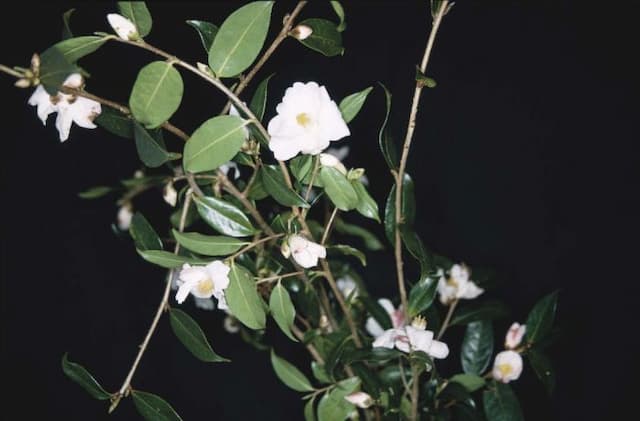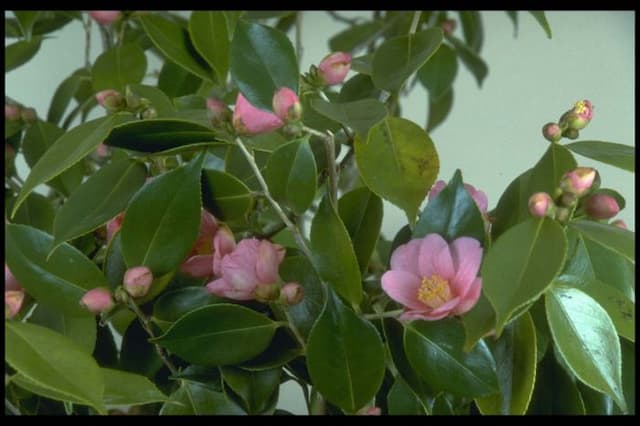Camellia Camellia 'Sweet Jane'

ABOUT
Camellia 'Sweet Jane' is a beautiful shrub known for its lush evergreen foliage and striking flowers. The leaves are glossy, deep green, and oval-shaped, providing a year-round backdrop of color and texture. The most captivating feature of Sweet Jane is its blooms, which are typically large and showy, drawing the eye with their beauty. The flowers of Sweet Jane are especially notable for their soft, romantic hues. Petals are often a delicate shade of pink, though they can range from almost white to a deeper pink, with some variations displaying a mix of shades that blend together seamlessly. These petals form a characteristic layering effect, creating a ruffled appearance that adds depth and interest to the overall presentation of the bloom. Each flower boasts a central cluster of contrasting yellow stamens, which stand out against the soft color of the petals, adding a burst of brightness and offering a lovely contrast. When in full bloom, the plant is covered in these enchanting flowers, which can create a stunning display that attracts the attention of passersby and is a favorite of garden enthusiasts. With a graceful and elegant demeanor, Camellia 'Sweet Jane' holds its blossoms proudly above the foliage, presenting them in a way that is both prominent and aesthetically pleasing, making it a beloved choice for adding splendor to gardens and landscapes where it is grown.
About this plant
 Names
NamesFamily
Theaceae
Synonyms
Sweet Jane Camellia
Common names
Camellia 'Sweet Jane'
 Toxicity
ToxicityTo humans
Camellias are not considered toxic to humans. If Camellia 'Sweet Jane', a variety of camellia, follows the profile of most camellias, then it would also be non-toxic. However, it is generally recommended to avoid eating ornamental plants due to the potential for stomach upset or an allergic reaction in sensitive individuals.
To pets
Similar to their toxicity in humans, camellias, including Camellia 'Sweet Jane', are typically considered non-toxic to pets. If a pet were to ingest part of a camellia plant, it is unlikely to suffer from serious poisoning. However, ingestion can sometimes result in mild gastrointestinal upset, such as vomiting or diarrhea, especially if consumed in large quantities.
 Characteristics
CharacteristicsLife cycle
Perennials
Foliage type
Evergreen
Color of leaves
Green
Flower color
Pink
Height
6-8 feet (1.8-2.4 meters)
Spread
6-8 feet (1.8-2.4 meters)
Plant type
Shrub
Hardiness zones
7
Native area
Japan
Benefits
 General Benefits
General Benefits- Ornamental Value: Camellia 'Sweet Jane' is renowned for its beautiful flowers, which add aesthetic appeal to gardens and landscapes.
- Seasonal Interest: This camellia typically blooms in the late winter to early spring, providing color and interest during a time when few other plants are in flower.
- Shade Tolerance: Camellia 'Sweet Jane' can thrive in partial shade, making it suitable for planting under larger trees or in shady garden corners.
- Evergreen Foliage: The plant has glossy, green leaves that remain on the shrub throughout the year, offering continuous foliage even when not in bloom.
- Low Maintenance: Once established, Camellia 'Sweet Jane' requires relatively little care, making it an easy addition to both residential and commercial landscapes.
- Durability: This variety of camellia is known to be quite resilient, tolerating various soil types and resisting many pests and diseases.
- Privacy Screening: With its dense growth habit, Camellia 'Sweet Jane' can be used as a privacy screen or hedge, providing a natural barrier for your garden or property.
- Wildlife Attraction: The flowers can attract pollinators like bees, which are beneficial for the surrounding environment and other garden plants.
- Versatility: It can be used in a variety of landscape designs, including formal gardens, woodland settings, or as a standalone specimen.
- Cultural Significance: Camellias have been cultivated for centuries in Asia and have cultural significance in countries like Japan and China, adding a touch of historical elegance to the garden.
 Medical Properties
Medical PropertiesThis plant is not used for medical purposes.
 Air-purifying Qualities
Air-purifying QualitiesThis plant is not specifically known for air purifying qualities.
 Other Uses
Other Uses- Camellia 'Sweet Jane' can be used for creating natural dyes for fabrics, offering a range of subtle hues dependent on the part of the plant used in the dye-making process.
- The fallen petals of Camellia 'Sweet Jane' can be collected and pressed into bookmarks or added into clear phone cases for aesthetic decoration.
- The petals of Camellia 'Sweet Jane' can be used in crafting homemade potpourri when dried, mixed with other fragrant botanicals and essential oils.
- Camellia 'Sweet Jane' petals can be infused in oils to create fragrant, natural scents for homemade candles and soaps.
- The leaves of Camellia 'Sweet Jane' are suitable for use in layering to create natural textures in mixed-media art projects.
- The sturdy stems of Camellia 'Sweet Jane' can be harvested and repurposed as natural supports for growing other climbing plants or vines in the garden.
- When pruned, the branches of Camellia 'Sweet Jane' can be shaped into wreaths and other forms of natural home decor.
- Camellia 'Sweet Jane' petals can be freeze-dried and used in decorative, edible flower arrangements atop cakes and pastries.
- The plant’s seedpods can be collected and utilized as unique additions to botanical jewelry, encapsulated in resin as pendants or earrings.
- The dense foliage of Camellia 'Sweet Jane' is sometimes used for privacy screening in small garden spaces or terraces.
Interesting Facts
 Feng Shui
Feng ShuiThe Camellia is not used in Feng Shui practice.
 Zodiac Sign Compitability
Zodiac Sign CompitabilityThe Camellia is not used in astrology practice.
 Plant Symbolism
Plant Symbolism- Adoration: Camellias often symbolize deep longing and adoration, making them a perfect gift for someone whom is greatly admired or adored.
- Devotion: The camellia's symmetrical form and long-lasting nature represent the steadfastness of true devotion.
- Affection: Giving a camellia can convey genuine affection towards a friend or family member.
- Perfection: Due to its perfect petals and rich colors, the camellia can represent the idea of perfection or an ideal.
- Longevity: Camellias are known for their long blooming season, so they often symbolize long life or immortality.
 Water
WaterCamellias, including 'Sweet Jane', prefer consistently moist soil but not waterlogged conditions. Water with approximately 1 inch of water once a week, and adjust for rainfall. During dry spells, water twice per week to maintain hydration. For potted Camellias, water until excess water drains from the bottom of the pot, ensuring the roots are sufficiently moistened. Reduce watering in the winter when the plant is not actively growing.
 Light
LightCamellias, including 'Sweet Jane', thrive best in partial shade with dappled sunlight. Avoid direct afternoon sun, which can scorch the leaves. The ideal spot is one that receives morning light and is protected from the intense sun of the afternoon.
 Temperature
TemperatureCamellias, including 'Sweet Jane', perform best in temperatures between 60°F and 80°F. They can handle minimum temperatures down into the upper 20s for brief periods. Avoid exposing the plant to temperatures below 20°F, as this can cause damage or death to the plant.
 Pruning
PruningPrune 'Sweet Jane' Camellias after they finish blooming to maintain shape and remove any dead or weak wood. Pruning is also necessary to encourage airflow and prevent disease. The best time for pruning is in late winter or early spring before new growth begins.
 Cleaning
CleaningAs needed
 Soil
SoilCamellias, including 'Sweet Jane', thrive in acidic soil with a pH between 5.5 and 6.5. A well-draining mix of 1/3 organic matter, like peat moss or leaf mold, 1/3 garden soil, and 1/3 perlite or pine bark fines suits them best.
 Repotting
RepottingCamellias typically need repotting every 2-4 years as they are slow-growing. It's best to repot 'Sweet Jane' in the spring before the growth season begins.
 Humidity & Misting
Humidity & Misting'Sweet Jane' camellias prefer moderate to high humidity, ideally between 40-60%, to maintain healthy leaves and buds.
 Suitable locations
Suitable locationsIndoor
Keep 'Sweet Jane' in bright, indirect light with high humidity.
Outdoor
Plant 'Sweet Jane' in partial shade with shelter from strong winds.
Hardiness zone
7-9 USDA
 Life cycle
Life cycleThe Camellia 'Sweet Jane', commonly referred to simply as Camellia, begins its life cycle when a seed germinates, usually in late winter or early spring. After sprouting, the seedling grows into a young plant with a strong root system and several leaves; this juvenile phase can take several years before the plant is mature enough to flower. Once mature, the Camellia will produce buds in late summer to fall that will bloom in winter or early spring, showcasing its ornamental flowers, typically pink or red in color. After pollination, which can be facilitated by insects like bees, the flowers will develop into seed pods. The seeds mature inside the pods before they are dispersed in the late summer, either by natural means or through human intervention for cultivation. As an evergreen, this plant will retain its leaves year-round throughout its life span, which can extend beyond 100 years in ideal conditions.
 Propogation
PropogationPropogation time
Spring-Early Summer
The Camellia 'Sweet Jane', commonly known simply as Camellia, can be propagated by semi-hardwood cuttings, a popular method that is typically done in late summer to early fall. To propagate by this method, a gardener would take a cutting about 4 to 6 inches long from a healthy parent plant, ensuring at least two sets of leaves remain on the cutting. The bottom set of leaves is removed, and the cut end is dipped in rooting hormone to encourage root growth. The prepared cutting is then planted in a pot filled with a moist, well-draining potting mix, such as a mixture of peat and perlite. The pot should be placed in a warm, brightly lit area but out of direct sunlight, and the soil should be kept consistently moist. To maintain high humidity, the pot can be covered with a plastic bag, which is removed once the cutting has rooted, usually in several weeks to a couple of months.









